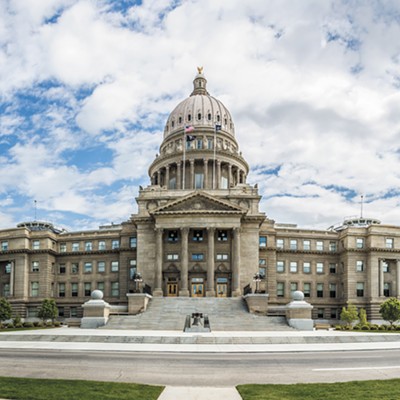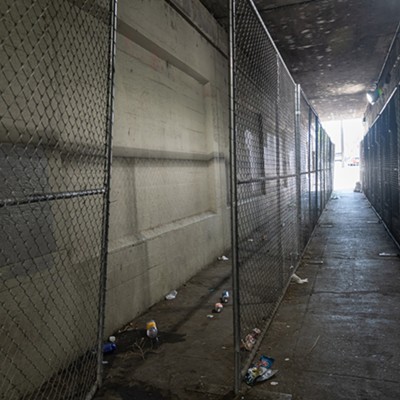On a recent fall morning in a climate-controlled, windowless room, a shoulder-high wooden crate was being carefully opened to reveal four long, covered boxes. The box lids were gently lifted one-by-one to reveal, nested inside, a family of dolls, hand-made by Coeur d’Alene tribal artisans, that have been at the Smithsonian for more than a century.
The richly decorated dolls — a man, woman and infant (who is in a beaded baby board) — are just a few of the artifacts being assembled from far-flung museums and collections for the exhibit “Sacred Encounters: Father De Smet & the Indians of the Rocky Mountain West.”
But the real treasure was in a bright red hooded jacket nearby. Under her cloud of white curls, Bertha Swan joined Felix Aripa as the two Coeur d’Alene tribal elders on hand to welcome the dolls home. Aripa delivered a traditional greeting to the 17 or so people in the room and said a prayer in the Coeur d’Alene language. Swan was a living connection to the dolls, created for and sold to a soldier by her great-grandfather, Peter Wildshoe.
It was a sweet homecoming that went on for more than an hour as the dolls were prepared for display. But the best moment was unplanned. On her way out, being pushed in her wheelchair by granddaughter Jaycee Goudy, Swan stopped at one of the large photographs near the end of “Sacred Encounters.”
The poster-sized photo showed a line of young Indian girls, in their school dresses, standing in front of the old Catholic boarding school at Desmet. It wasn’t dry history.
“She knew all of those girls. Those were her playmates,” explains Raymond Brinkman, a linguist who works for the tribe.
Many of the other tribal members in the new museum that morning were also stopped short by photographs on the walls. It wasn’t dry history for them, either. It was family — great-grandmothers, aunties, uncles. When the exhibit opens Saturday, there will be an added element, as these voices — some long dead — will be heard once again via tape recording.
This is the power of “Sacred Encounters.”
Jacqueline Peterson was a professor of history at Washington State University in the 1990s when she assembled the original “Sacred Encounters,” which traveled the western United States and Canada from 1994 to 1997. She wanted to tell the story of Jesuit missionaries coming to the interior Northwest to meet tribal people who had been waiting for them — and the profound effects the encounters had on both sides.
The exhibit was groundbreaking in several ways. It dealt with religion. It gave Native voices equal weight to western European ones. It included music, sound and film.
The effect was powerful.
“At the opening in Bozeman, it was very emotional,” Peterson says in a telephone interview from Portland, where she has recently retired from teaching at WSU’s Vancouver campus.
At Bozeman, Peterson says she walked into a room and, “I remember seeing a group of elders [Flathead Salish and Coeur d’Alene] and a group of Jesuits, and they were crying together. It was a profound experience. It was sadness, and it was pride that the story was being told and it was about them.”
It was so overwhelming, in fact, that the Coeur d’Alene Tribe approached WSU about buying “Sacred Encounters.” For $2 million, they got the bones of the exhibit, the furnishings and gear.
“There are no objects. All the artifacts went back to 50 lenders,” Peterson says of the museums and collections — from as far away as Belgium — that donated items. “I said, ‘To get those back, you’ve got to build a major museum.’”
And so they did. The tribe, with help from Silver Valley businessmen like the late Harry Magnuson, raised another $3.6 million to construct a tidy little museum at Old Mission State Park that has all the security and climate controls needed for the safe display of fragile objects. And on Saturday, Sacred Encounters opens its permanent home. There is a tiny Bible, beaded by its Indian owner. There’s a letter De Smet wrote in 1821 to his father, explaining his choice to become a missionary. There are gleaming chalices.
But it’s not static. Visitors walk through a rich audio-visual experience — nature sounds and Coeur d’Alene singing fading into Gregorian chants and Latin prayer — as the exhibit creates a portrait of two cultures, two faiths colliding.
Quanah Matheson, culture director for the Coeur d’Alene Tribe, says the exhibit touches on darker aspects of the encounter as well.
“This is an honest exhibit. It is important not to tell a distorted history,” Matheson says. Especially to have it at Cataldo, he adds. The graceful chapel, perched atop a knoll above the North Fork Coeur d’Alene River, was constructed (beginning in 1848) by white hands and brown hands working together. Perhaps it’s significant that it is the oldest standing building in Idaho.
“This exhibit tries to tell a complex story, fairly and with understanding,” Peterson says. “Where else should it be?”
Peterson says she was deeply affected by “Sacred Encounters.”
“I learned that these were people — and I’d say the Coeur d’Alene are representative of most Native American people in the country — who learned to forgive the unforgivable. That if you carry hatred in your heart, it will eat you up.”
“Sacred Encounters” • Old Mission State Park • off Interstate 90 at Cataldo (Exit 39), 58 miles east of Spokane • Open 9-5 daily • Park entry is $2, $1 for students, $5 per family • (208) 682-3814





















